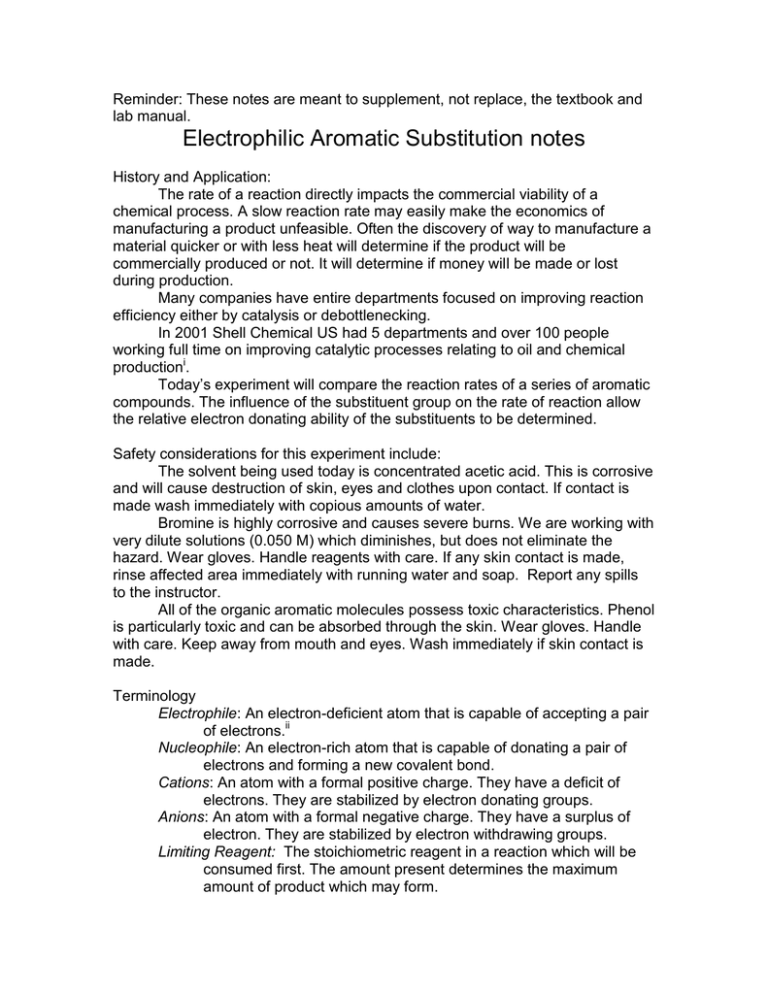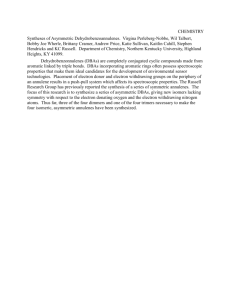Electrophilic Aromatic Substitution notes
advertisement

Reminder: These notes are meant to supplement, not replace, the textbook and lab manual. Electrophilic Aromatic Substitution notes History and Application: The rate of a reaction directly impacts the commercial viability of a chemical process. A slow reaction rate may easily make the economics of manufacturing a product unfeasible. Often the discovery of way to manufacture a material quicker or with less heat will determine if the product will be commercially produced or not. It will determine if money will be made or lost during production. Many companies have entire departments focused on improving reaction efficiency either by catalysis or debottlenecking. In 2001 Shell Chemical US had 5 departments and over 100 people working full time on improving catalytic processes relating to oil and chemical productioni. Today’s experiment will compare the reaction rates of a series of aromatic compounds. The influence of the substituent group on the rate of reaction allow the relative electron donating ability of the substituents to be determined. Safety considerations for this experiment include: The solvent being used today is concentrated acetic acid. This is corrosive and will cause destruction of skin, eyes and clothes upon contact. If contact is made wash immediately with copious amounts of water. Bromine is highly corrosive and causes severe burns. We are working with very dilute solutions (0.050 M) which diminishes, but does not eliminate the hazard. Wear gloves. Handle reagents with care. If any skin contact is made, rinse affected area immediately with running water and soap. Report any spills to the instructor. All of the organic aromatic molecules possess toxic characteristics. Phenol is particularly toxic and can be absorbed through the skin. Wear gloves. Handle with care. Keep away from mouth and eyes. Wash immediately if skin contact is made. Terminology Electrophile: An electron-deficient atom that is capable of accepting a pair of electrons.ii Nucleophile: An electron-rich atom that is capable of donating a pair of electrons and forming a new covalent bond. Cations: An atom with a formal positive charge. They have a deficit of electrons. They are stabilized by electron donating groups. Anions: An atom with a formal negative charge. They have a surplus of electron. They are stabilized by electron withdrawing groups. Limiting Reagent: The stoichiometric reagent in a reaction which will be consumed first. The amount present determines the maximum amount of product which may form. Electron Donating Group: This is a group that is able to give or share electron density either by inductive or resonance effects. Resonance effects are more substantial than inductive effects. Electron Donating Groups (EDG) stabilize cations and destabilize anions. Electron Withdrawing Groups: This is a functional group with a low electron density which pulls electron density away from neighboring groups. Electron withdrawing groups (EWG) destabilize cations and stabilize anions. Reaction Rate: This is a mathematical calculation which depends on the rate constant of the reaction and usually on the concentration of one or more of the starting materials. React to Completion: When a reaction has been allowed to proceed for a sufficient amount of time, all of the limiting reagent has been consumed and no more product is able to be formed. Rate Determining Step: The slowest step in a mechanism. The speed in which this step occurs dictates the speed of the total reaction. 1. The Reaction Electrophilic aromatic substitution (EAS) reactions are an important tool in any synthetic organic chemist’s toolbox. EAS reactions allow the introduction of many different functional groups onto an aromatic ring system. The overall reaction involves the substitution of one hydrogen (or sometimes multiple H) on the aromatic ring system by an electrophile, designated E+. Generic Reaction: Ar-H + E+ -> Ar-E + H+ 2. In this experiment the electrophile will be bromine and a variety of substituted benzene molecules will be the aromatic. Overall Reaction The “G” indicates the presence of some group on the ring before the addition of bromine. In this experiment 6 different substituents will be used as “G”. The bond to Br across the ring and not emanating from a particular carbon indicates that the bromine is attached to the ring, but the exact location is not specified. The resulting product has two groups attached, Br and G, with their relative orientation a mixture of o, m, and p. 3. The EAS mechanism consists of two steps. The first step is the rate determining step. The first step is one of the bonds of the aromatic acting as the nucleophile and forming a bond to the electrophile, generating a delocalized cation and simultaneously destroying the aromaticity of the ring. This intermediate is called either the sigma complex or arenium ion. The cation can resonance delocalize to three positons around the ring. The presence of substituents on the aromatic ring, greatly influence the rate of the first step, and hence the overall rate of the reaction. The second step consists of a base assisting the proton leave, with the electons of the C-H bond coming back into the ring thereby reforming aromaticity and producing the final product. This can be shown from any of the resonance forms of the sigma complex. 4. Cations are electron deficient. They are stabilized by electron donating groups and de-stabilized by election withdrawing groups. If the pre-existing group on the aromatic ring is an electron withdrawing substituent, the cation is destabilized, and the rate of the reaction will be much slower, or less than the rate of the unsubstituted aromatic ring, benzene. If the pre-existing group on the aromatic ring is an electron donating substituent, the cation is stabilized, and the rate of the reaction will be much faster, or greater than the rate of the unsubstituted aromatic ring, benzene. RATE Aromatic-EDG > Benzene > Aromatic-EWG In addition, a strong electron donating group will enhance the rate of the reaction more than a moderate electron donating group. Strong electron donating groups have one or more lone pair electrons which can formally donate electrons by resonance. Resonance effects are stronger than inductive effects which occur by through bond donation or inductive effects ( donors). The observed comparative reaction within a series of substituted aromatic systems, will indicate the strength of their electron donation. 5. For illustrative purposes, consider two substituted aromatics(G1-Ar and G2Ar) undergoing EAS reactions. If Group2 (G2) is a stronger electron donating group than Group 1 (G1), then the cation intermediate which forms from G2-Ar will be lower in energy than the cation intermediate from G1-Ar. This is shown in the below reactions and reaction coordinate diagram. The activation energy necessary to form these intermediates will be different, and the reaction rate of G2-Ar will be faster than the reaction rate of G1-Ar. The stronger the electron donating group, the faster the EAS reaction. 6. By experimentally comparing the reaction rates of 6 different substituted aromatic materials, the electron donating strength of the groups may be ranked. 7. The more electronegative an atom, the less willing that atom will be to donate electrons. This comes into play when examining the difference in electron donating ability of nitrogen and oxygen. 8. Table 1. Electron donating properties of substituents.iii Activating Activating Activating Deactivating Deactivating Strong Moderate Weak Weak Moderate Electron Electron Electron electron electron Donating Donating Donating donors, ( withdrawing Groups ( Groups Groups ( donation, (diminished donors) donors) withdrawing donors) (o,p directors) -NH2 -NHCOR -R -F -COR -NHR -OCOR -Ar -Cl -COH -NR2 -O-R -Br -COOH -OH -O-CH3 -I -COOR -O-C≡N -SO3H Deactivating Strong Electron withdrawing groups -NO2 -NR3+ -CF3 -CCl3 9. Temperature and Reaction Rate. Another factor which significantly effects the rates of reaction is temperature. The Arrhenius equation (Rate kT, where k is the rate constant for that reaction and T is temperature) explains this strong correlationiv. As temperature increases, the rate increase. A useful rule of thumb is reaction rates double for each ten degree Celsius increase in reaction temperature. Hence if a reaction takes one hour to complete at 25oC, the same reaction will be complete in 30 minutes at 35oC or 15 minutes at 45oC. 10. The two materials with the slowest rate of reaction at room temperature will be tested at a much higher temperature. This will illustrate the change in rate with temperature and allow the differentiation of these two materials. 11. A limiting reagent in a reaction is that material which will be consumed first, and determines how much product can be formed. The reaction will stop once this material is consumed. In today’s experiment, the electrophile Bromine is the limiting reagent. The Electrophilic aromatic substitution reaction will continue until all of the bromine is consumed. Bromine has a distinct brown color. When all the bromine is consumed, there is no more brown from the bromine. Hence, the end of the reaction can be observed by the disappearance of the brown color. → Aromatic + Bromine Aromatic-Br + HBr Excess Limiting Product side product Brown clear clear Being able to discern when the brown color has disappeared is complicated if the starting aromatic material possesses a color. 12. Following are the substituted aromatic materials which will be used in today’s experiment. Write all of these down in your notebook. 13. All of these aromatic materials have been made up into 0.20M solutions in 90% acetic acid. The Bromine is available as a 0.050M solution in 90% Acetic Acid. Acetic acid is the common name of ethanoic acid. Most acids less than 10 carbons are known primarily by their common names. References. Gilbert, J.C., Martin, S.F., Experimental Organic Chemistry, a miniscale and microscale approach, 2nd edition, Saunders Publishing, 1998, 394-397, 423-425 Solomons, T. W. G., Fryhle, C. B, Organic Chemistry, 9th Ed, Wiley, 2008, 637676 L.G. Wade, Jr Organic Chemistry, Prentice 2003, p739 and Carey, F. A, Sundberg, R. J., Advanced Organic Chemistry Part A, Kluwer, 4th ed, 2000, p208 i Personal Documentation, S. L Weaver, October 2012 D. Klein, Organic Chemistry, Wiley,NJ, 2012, pp 255 iii L.G. Wade, Jr Organic Chemistry, Prentice 2003, p739 and Carey, F. A, Sundberg, R. J., Advanced Organic Chemistry Part A, Kluwer, 4th ed, 2000, p208 ii J. W. Moore, R. G. Pearson, Kinetics and Mechanism, Wiley, 2nd Ed, 1981, p 31-34 iv Revised: June 11, 2015, S. L. Weaver




